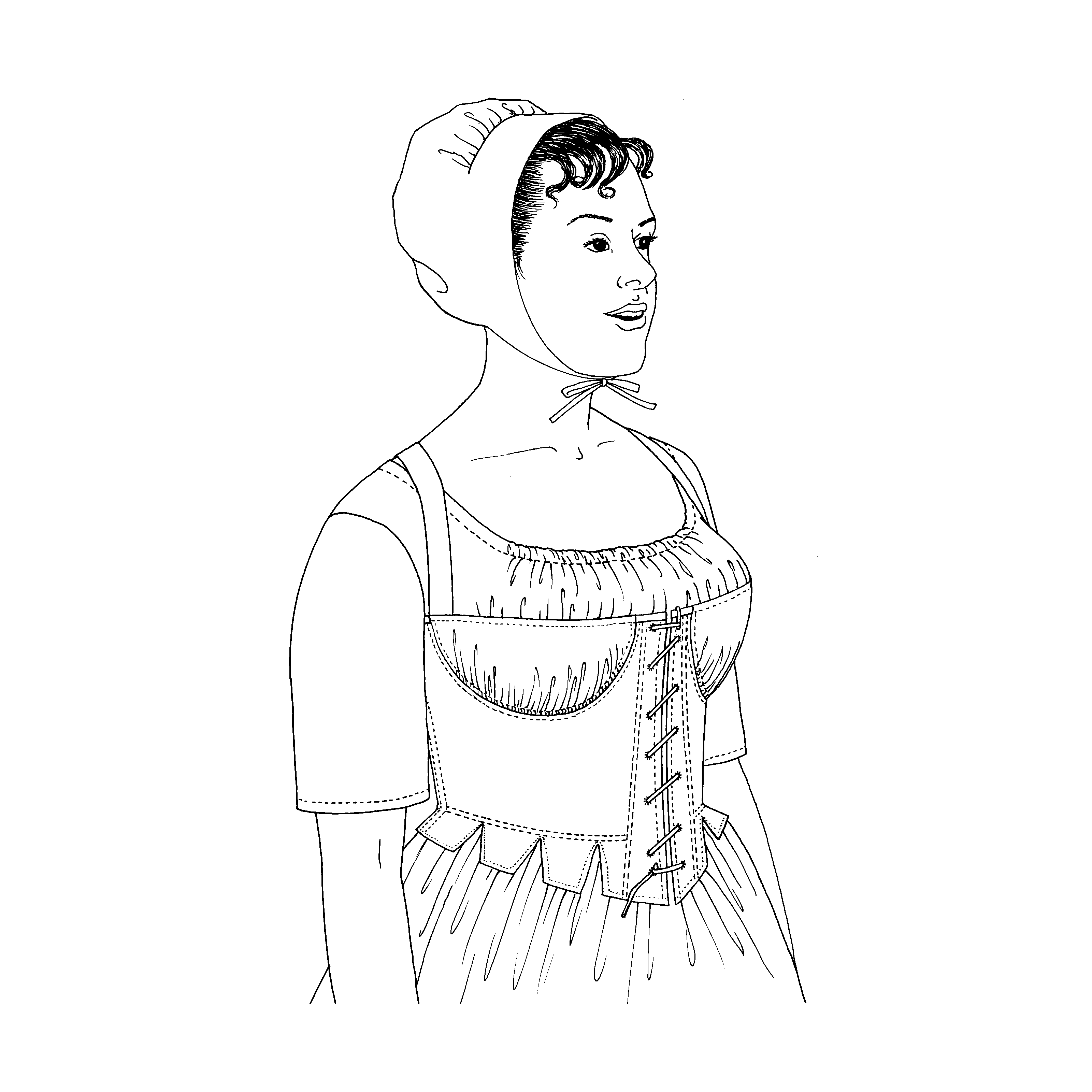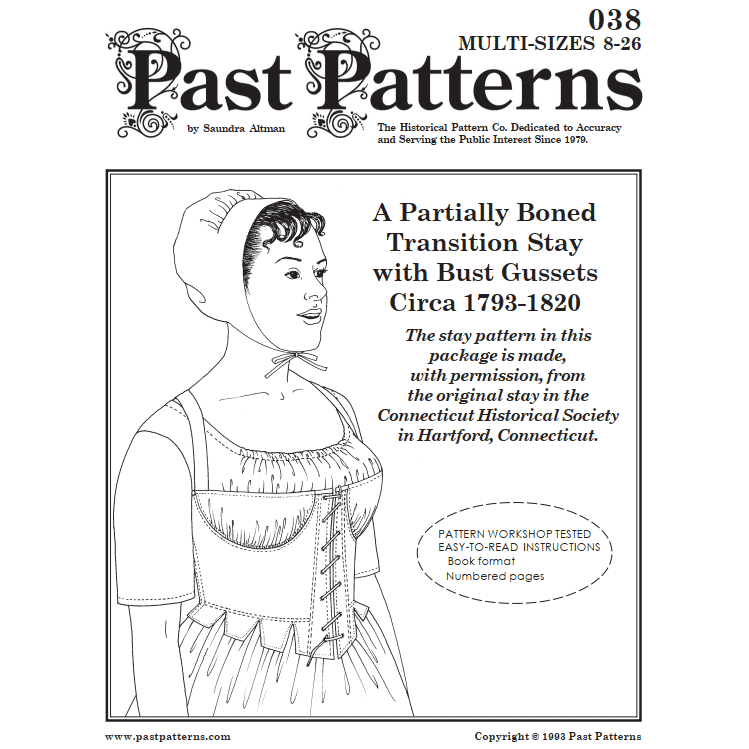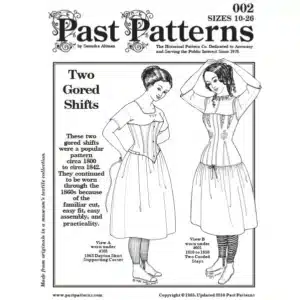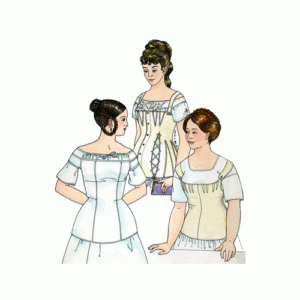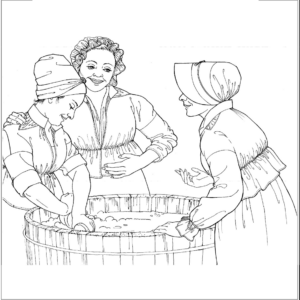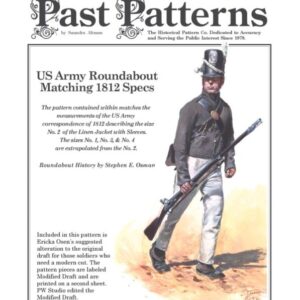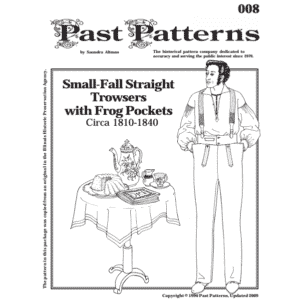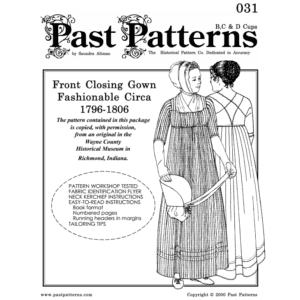Federalist Era Partially Boned Transition Stay Downloads | Past Patterns 0038
$10.50
Instant download Federalist Era Partially Boned Transition Stay pattern (1793-1820) with printable files in multiple formats for Sizes 8-26. No shipping wait.
997 in stock
Get Free Shipping
On all US Orders over $50!
Federalist Era Partially Boned Transition Stay Downloads | Past Patterns 0038
$10.50
Instant download Federalist Era Partially Boned Transition Stay pattern (1793-1820) with printable files in multiple formats for Sizes 8-26. No shipping wait.
997 in stock
Get Free Shipping
On all US Orders over $50!
All of our patterns tell a story.
Why Choose This Pattern?
Federalist Era Partially Boned Transition Stay Downloads: Museum-Quality Historical Pattern (1793-1820)
This Federalist Era Partially Boned Transition Stay Downloads package delivers immediate access to our meticulously researched pattern, drafted directly from a documented garment in the Connecticut Historical Society (reference #1963-42-4). Experience the convenience of a digital pattern while creating a period-correct foundation garment that shaped the distinctive silhouette of the Federalist Era.
Historical Significance of the Federalist Era Partially Boned Transition Stay
The Federalist Era Partially Boned Transition Stay represents a pivotal evolution in women's undergarments from 1795 to 1810. During this transformative period, the rigid, fully-boned stays of the 18th century gradually gave way to more comfortable, shorter versions with strategically placed boning. This digital pattern allows you to recreate this essential historical garment with complete accuracy.
Fashion historian Nancy Rexford explains that these front-opening foundation garments were designed to create a smooth silhouette under the delicate, often sheer fabrics popular during this era. The original garment that inspired this Federalist Era Partially Boned Transition Stay Downloads pattern was worn by Abigail Arthur Hazard (1759-1820) and exemplifies the practical innovation that supported the fashionable empire Waistline while providing necessary Bust support.
Explore more about this fascinating transitional period in fashion through the Metropolitan Museum of Art's timeline on early 19th-century dress evolution, which contextualizes how the Federalist Era Partially Boned Transition Stay influenced women's fashion during this pivotal historical period.
Digital Download Benefits of the Federalist Era Partially Boned Transition Stay
- Instant Access - Receive your Federalist Era Partially Boned Transition Stay Downloads immediately after purchase
- Multiple Printing Formats - PDF files formatted for A0, A4, 8.5x11", and 36" wide paper
- Print What You Need - Print only the Size you need or the entire pattern for multiple Sizes
- Unlimited Reprints - Make replacement pieces whenever needed
- Space-Saving Storage - Keep your pattern digitally without physical storage requirements
- No Shipping Costs or Delays - Avoid international shipping fees and waiting periods
- Environmentally Friendly - Reduce packaging waste with digital delivery
Digital File Specifications for the Federalist Era Partially Boned Transition Stay
The Federalist Era Partially Boned Transition Stay Downloads package includes multiple PDF files optimized for different printing needs:
- A0 Format (33.1 × 46.8 inches) - Professional printing for the complete pattern on one sheet (4MB PDF)
- A4 Format (8.27 × 11.69 inches) - Standard international paper Size with assembly guide (6MB PDF)
- US Letter Format (8.5 × 11 inches) - Standard US paper Size with assembly guide (6MB PDF)
- 36" Wide Format - For printing on wide-format home printers or at copy shops (5MB PDF)
- Comprehensive Instructions - Detailed PDF manual with historical background, sizing, construction techniques, and fitting guidance (8MB PDF)
Total file Size: Approximately 25MB (zip file containing all pattern PDFs and instruction manual)
Printing Instructions for the Federalist Era Partially Boned Transition Stay
Each format includes detailed printing instructions:
- For A0 Format: Take to a professional print shop and request printing at 100% scale with no margins or scaling. Confirm measurements against the test square before cutting your fabric.
- For A4/Letter Formats: Print at home using the "Actual Size" setting with no scaling. Assemble using the numbered grid system, aligning registration marks and securing with tape. The first page contains a layout diagram for easy reference.
- For 36" Wide Format: Request large-format printing at a copy shop, specifying no scaling and 100% Size. This format minimizes assembly while maintaining all sizing accuracy.
Each file includes test squares to verify your printing scale is correct before cutting fabric.
Pattern Features of the Federalist Era Partially Boned Transition Stay
Our Federalist Era Partially Boned Transition Stay Downloads package provides everything included in our physical pattern, digitally optimized for your convenience:
- Comprehensive sizing from 8-26, accommodating Bust measurements from 32½" to 48"
- Detailed historical background notes exploring the evolution of stays from the 18th century through early 19th century
- Illustrated documentation of transition stays from multiple museum collections
- Step-by-step fitting and construction instructions with period-appropriate techniques
Materials and Yardage Requirements
The original Federalist Era Partially Boned Transition Stay was crafted from nankeen, a natural yellow cotton. Your digital pattern includes comprehensive materials lists and recommendations:
- 45" Fabric Requirements:
- Sizes 8-12: 1 yard
- Sizes 14-20: 1 1/16 yards
- Sizes 22-26: 1 1/8 yards
- Detailed notions list with historically appropriate options
- Boning recommendations with modern alternatives
Skill Level Required for the Federalist Era Partially Boned Transition Stay
This Federalist Era Partially Boned Transition Stay Downloads pattern requires intermediate to advanced sewing skills. The construction involves precise fitting techniques, working with 12 pattern pieces, and historical hand-sewing methods. The most challenging aspects include:
- Creating and fitting the Bust gussets with proper gathering techniques
- Constructing even, parallel boning channels
- Hand-sewing the eyelets for front lacing
- Period-appropriate seam finishing methods
Prior experience with historical undergarments or corsetry is highly recommended. The pattern includes detailed illustrations and instructions to guide you through each construction step, but familiarity with historical garment techniques will enhance your success with this project.
Learn more about the specialized sewing techniques of this period through the Victoria and Albert Museum's articles on historical stays and corsets, which provide valuable context for understanding the construction methods used in the Federalist Era Partially Boned Transition Stay.
Why Choose Past Patterns Digital Downloads?
Our Federalist Era Partially Boned Transition Stay Downloads exemplify our commitment to historical accuracy while embracing modern convenience:
- Over 40 Years of Historical Accuracy – Our patterns are drafted from original garments and museum collections
- Thorough Research & Documentation – Each pattern includes references to historical sources and tailoring guides
- Designed for Serious Reenactors & Costumers – Perfect for period film productions, museums, and dedicated historical sewists
- Digital Convenience with Historical Precision – Enjoy the benefits of digital delivery without sacrificing historical accuracy
- Expanded Guidance for Accuracy – Additional insights on fabric selection, bone placement, and period hand-finishing techniques
Scholars at organizations like the Colonial Williamsburg Foundation recognize the importance of accurately recreating these transitional garments to understand fashion evolution during this crucial period in American history.
Prefer a physical printed pattern? Get this pattern in our traditional format here.
Original Content by Past Patterns 1979-2025. All rights reserved
Sizing Information
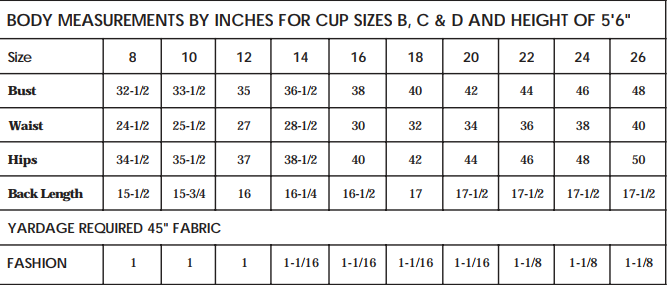
(Metric size sheet opens as a PDF in a new browser tab)
Preferred Vendors
Past Patterns works with vendors from all over the world to help us replicate the amazing articles of clothing. Now you can too!
Visit our preferred vendors page to order directly from some of our top recommended suppliers.
FAQ's
(Frequently asked questions)
Why are both Trowsers and Trousers listed on site?
Over the last 200 years, much like the human body, our style of language has changed. For vintage patterns, we attempt to use the language of the day where possible.
Can you grade (edit) a Vintage Revival pattern for my size?
please contact us with the specific pattern number and the specifications you require. We have staff available for this for an additional fee.
What sizes do Past Patterns patterns come in?
Our patterns, with some exceptions, are manufactured in sizes 8 through 26 for women and sizes 34 through 54 for men. Most patterns are multi-sized. For a complete listing of measurements in inches see the size chart.
Do you have vintage patterns (manufactured prior to 1950) that you want to sell?
we are always on the lookout for original, American designed, vintage patterns especially for categories outside of current items. We are interested if you have 1 pattern or 1000 patterns. Give us a call to discuss.
Why is my pattern size different from my off the rack dress size?
We use the U. S. Board of Standard Measurements to size our patterns. The ready made clothing manufacturers have their own set of sizes developed from their own statistics. For a complete listing of measurements in inches see the size chart.
How are the patterns packaged?
We package our patterns in two forms: Bond Paper and Tissue. Except for the Tissue patterns, each is slipped into a reusable plastic sleeve. Many contain documentation in the form of Historical Notes or the printer ie., Butterick. Because the patterns are printed in house to order, they can take from three to seven days. Tissue patterns, which are printed out of house, are available to ship immediately.
What does a Corset Kit contain in addition to the Corset pattern?
In addition to the pattern, the kits contain everything you need to make the corset except the thread. The kits contain, according to their type, fabric and lining, stays, clasp or busk board, back lacing, tape for finishing the edges, trim lace, ribbon, leather, tin stock, waist tape, punch and setter, eyelets, marking pencils, cording, reed and a loop turner.
Need a pattern in your language?
we can translate our instructions into just about any language
Have an old and incomplete Past Patterns item. What can I do?
The answer depends on if the pattern is still in production or not. If it is, please mail us the old pattern and we will ship you a copy of the latest pattern for a minimal fee along with normal shipping charges. If the item is no longer in production, we would need to know exactly what you have to determine the best course of action to help you.
What is the difference between a Past Patterns original pattern and a Vintage Revival pattern?
The Past Patterns originals were designed in house and based upon the research, disassembly and time of Saundra Ros Altman. These designs come from finds all over the United States reaching from San Diego, California to the Smithsonian Museum in Washington, DC. She created the initial patterns, the sizing charts and the instruction content. Many of the these patterns are multi-sized or are available in various sizes. For the most part, these designs are done taking into account the modern human body's shape, height and weight. The Vintage Revival patterns are traces or copies of an old, mass produced pattern; the first mass produced patterns came out in the 1850s. For the most part, you get exactly what came in the original package; in some cases, Saundra has appended historical notes to the instructions. The Vintage Revivals patterns, being copies of the originals, generally only come in one size and are based upon the size and shape of the human body from the era the pattern came from.
What software do you use to create patterns?
We utilize PW Studio for our designs. Isabelle Lott, a contributor over the years to Past Patterns, is the owner of the company and will be happy to answer an software related questions you have. Her software is available for licensing.
What measurements do I need to know to order a Corset Kit?
The bust and back length. The back length is measured from the prominent bone at the base of the neck to the natural waistline.
Where can I see the appropriate clothing fabrics for the 18th and 19th centuries?
You can see 1740 through 1940 fabrics in a book titled "Textile Designs" by Susan Meller and Joost Elffers. The subtitle states, "Two Hundred Years of European and American Patterns for Printed Fabric by Motif, Style, Color, Layout and Period and 1,823 Illustration in Color." What they don't say is that 90% of the swatches pictured are life size. The ISBN is 0-8109-3853-7. A second book is Wearable Prints, 1740-1860, History, Materials, and Mechanics by Susan W. Greene. The ISBN is 978-1-60635-124-6. Great books! Order it from your local library that has interlibrary loan capability if you cannot afford the price. There are now many sources for appropriate fabric through the Internet.
Where can I find antique patterns to purchase?
On the Internet try: "Patterns from the Past."
Need a pattern tomorrow?
we do offer expedited domestic shipping for extra fees. We can also expeditie international shipments but delivery dates overseas cannot be promised.
Becoming a Wholesalers of our patterns
We offer Wholesalers significant discounts that will allow both your and our businesses to flourish.
Why don't we sell PDFs of our patterns - First due to piracy. We have spent over 40 years creating and tracing these patterns along with researching them. We print and ship all of our patterns ourselves. If we started sending out PDFs, in no time, copies of our Intellectual Property would be all over the internet and we would be out of business. Second, some of our patterns are constantly being updated. We want our clients to get the BEST POSSIBLE version of our products.

